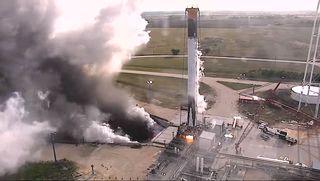Watch SpaceX's 1st Test-Fire of a Used Falcon 9 Rocket

Billionaire entrepreneur Elon Musk's private spaceflight company, SpaceX, is another step closer to making its Falcon 9 rockets fully reusable.
Late yesterday (July 28), the company released this video of its first test firing of a used Falcon 9 rocket stage, one that already launched and landed during a mission in May. The burn lasted for about 2 minutes and 30 seconds, and a brief description of the video said the test was "full duration."
Hans Koenigsmann, vice president of flight reliability at SpaceX, said on July 16 that the company plans to launch one of its used rockets this fall, assuming it has a customer for the flight. The company also plans to reuse one of its Dragon cargo capsules for a cargo delivery mission to the International Space Station, representatives of SpaceX and NASA said earlier this month.
Musk has voiced his dedication to making rocket boosters reusable, with the goal of significantly lowering the cost of going to space. In most rocket designs, the first stage of the engine is discarded after one use.
SpaceX has successfully launched and then landed five different Falcon 9 rocket boosters since December 2015, but the company has not yet reused any of those boosters. The test firing took place at SpaceX's McGregor test center in Texas. The Falcon 9 that is being test fired in the new video originally launched into space on May 6, sending the Japanese communications satellite JCSAT-14 into orbit. That rocket is not expected to fly again, according to SpaceflightNow, but is still important for understanding how the boosters respond to repeated burns.
SpaceX is not the only company pursuing reusable rockets. Amazon.com founder Jeff Bezos is also founder and CEO of the private spaceflight company Blue Origin, which has already done multiple launches of its suborbital vehicle, New Shepard. The company is also working on a reusable orbital vehicle.
The private spaceflight company Virgin Galactic (backed by entrepreneur Richard Branson) is working on a plane that could launch spacecraft into suborbital space, and Vulcan Aerospace (backed by Microsoft co-founder Paul Allen) is working on the largest airplane ever built, which could launch spacecraft to even higher altitudes.
Get the Space.com Newsletter
Breaking space news, the latest updates on rocket launches, skywatching events and more!
Follow Calla Cofield @callacofield. Follow us @Spacedotcom, Facebook and Google+. Original article on Space.com.
Join our Space Forums to keep talking space on the latest missions, night sky and more! And if you have a news tip, correction or comment, let us know at: community@space.com.

Calla Cofield joined Space.com's crew in October 2014. She enjoys writing about black holes, exploding stars, ripples in space-time, science in comic books, and all the mysteries of the cosmos. Prior to joining Space.com Calla worked as a freelance writer, with her work appearing in APS News, Symmetry magazine, Scientific American, Nature News, Physics World, and others. From 2010 to 2014 she was a producer for The Physics Central Podcast. Previously, Calla worked at the American Museum of Natural History in New York City (hands down the best office building ever) and SLAC National Accelerator Laboratory in California. Calla studied physics at the University of Massachusetts, Amherst and is originally from Sandy, Utah. In 2018, Calla left Space.com to join NASA's Jet Propulsion Laboratory media team where she oversees astronomy, physics, exoplanets and the Cold Atom Lab mission. She has been underground at three of the largest particle accelerators in the world and would really like to know what the heck dark matter is. Contact Calla via: E-Mail – Twitter
